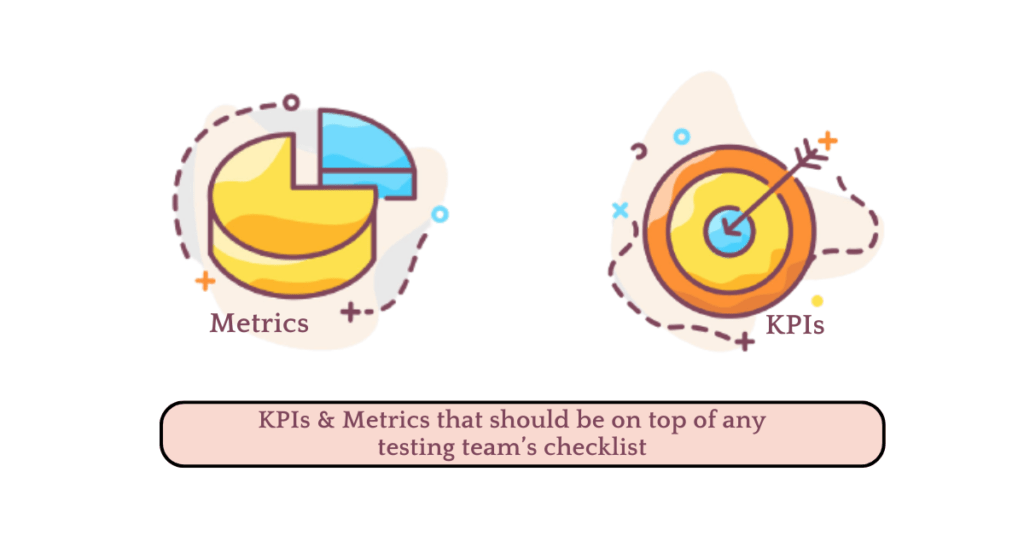
Important Metrics & KPIs for Software Quality Assurance
The success of any software product relies heavily on how well its quality is measured. The efficiency of the testing process is a key factor in ensuring revenue. Knowing what differentiates a good testing procedure and a bad one means we must have extensive knowledge of various software testing metrics and key performance indicators (KPIs). KPIs will help us determine the fittingness and suitability of the testing team and the testing types provided.
As a leading software testing provider, Q-Pros follows extensive criteria to define a successful testing process. Our metrics range from team members’ efficiency to solid academic and rhetorical factors based on universal standards.
In this article, we will investigate the metrics and KPIs of software testing that any application should cover to be suitable for release.
Here are the KPIs & Metrics that should be on top of any testing team’s checklist:

Derivative Metrics – Derivative metrics are identifiers that allow the testing team to increase the accuracy of their testing process.
Defect Density – Defect density measures the number of issues faced concerning a fixed period, this helps the testing team decide if an application is ready for post-production stages or if it might require more testing. A formula used to know the Defect Density is Defect count divided by the size of release divided by module.
Defect Removal Efficiency – Defect removal efficiency (DRE) is the number of defects that a developer can remove before the official release date. In other words, it is the number of defects resolved divided by the number of defects at the current time of measurement. DRE is calculated across the test phases.
Defect Category – It is essential to categorize the aspects of the software we are testing for, such as performance, functionality, or reliability, and many more.
Review Efficiency – Review efficiency involves documentation of defects; it aims to decrease the probability of defect leakage in subsequent stages of testing. (RE) = Total number of review defects / (Total number of review defects + Total number of testing defects) x 100.
Time to Test – Time of test is a key performance indicator that helps the testing team know the amount of time it takes to transition from the stage of testing to the stage of completion. It also allows us to know the level of effectiveness that the testing team operates on.
Test Instances – A KPIs that measures the number of instances available in a test set, this helps increase the velocity of test execution plans.
Passed Tests– This KPIs is measured by monitoring the implementation of every configuration within a test. It measures how well those configurations are in detecting the defects during the testing phases.
Defects Fixed per Day – This KPIs, as the name indicates, is measuring or keeping track of the total number of defects fixed daily, this helps us monitor the progress of the overall project.
Test Coverage – The test Coverage metric allows to define the level to which the software’s complete functionality is tested. It resembles the completion of testing activities and would later be used as criteria of which we decide on a test as concluded. Requirement Coverage is (Number of requirements covered divided by the total number of requirements) x 100
Defect Resolution Time – This KPIs involves measuring the time it takes the testing team to verify a fix of a defect. This KPI helps us highlight where certain team members’ efforts are directed and how long it takes them to resolve certain tasks.
Test Economic Metrics – Testing is associated with cost, and testing procedures, by nature, slow the production by adding various steps in between the production era. Several metrics should be put in mind prior to deciding the testing approach adopted:
- The overall cost of testing
- How much it would vary in execution to the estimated budget
- Variance from the schedule
- Cost per bug
- The cost of not conducting any test
Test Team Metrics – This set of metrics simply concludes how well the testing team is working, this could help us acquire information about certain team members or entire team sections involved in a specific area of the test. In return, this provides a way for us to empower the team in certain required areas and sustain a stronger bond between team members. These metrics include but are not limited to:
- The number of test cases conducted by each team member
- Test cases directed to each test team member
- Returned defects are distributed to team members
Active Defects– This KPI includes identifying the open or fixed defects.
Automated Testing – It is mandatory for every testing team to segregate high-priority defects that require automated means for testing.
Test Case Quality – Both a metric and a KPI, measuring a test case Quality helps us evaluate test cases in accordance with the desired result. To accomplish test case quality, we rely on the following:
- Tests should be written and organized in a report, this report will include findings regarding defects and bugs.
- Test requirements should be pre-established.
- Testing data must cover all probable scenarios.
- Testing data must cover Pass/Fail scenarios.
Summary
These Metrics and Key performance indicators are the “Make it or break it” factor to the success of any testing company. Knowing the measure of success on every level of the project gives excellent results in the end.
Implementing software testing metrics and key performance indicators will increase the effectiveness of the testing efforts. At Q-Pros, we take pride in involving experts who are extensively knowledgeable about all metrics and KPIs. Know more about us and request one of our services.
Online Test Request

